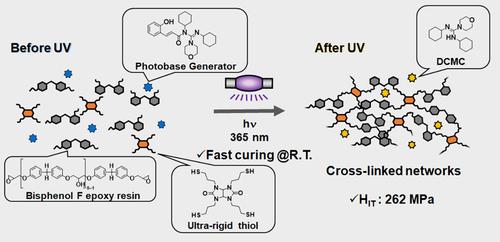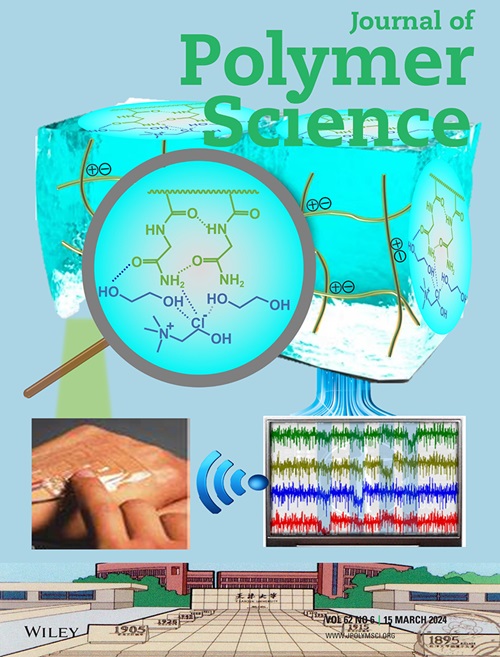Rational design of a room‐temperature curing method, based on the epoxy–thiol click reaction, for UV‐curable hard coatings with ultrahigh strength and adhesion
IF 3.9
3区 化学
Q2 POLYMER SCIENCE
引用次数: 0
Abstract
In recent years, there has been a growing demand for UV‐curable hard coatings because they offer several advantages, for example, lower energy consumption and the absence of volatile organic compound emissions. Anionic UV curing with photobase generators (PBGs), such as epoxy–thiol cross‐linking, enables curing under ambient conditions. However, designing a room‐temperature photoanionic curing system for epoxy–thiols remains challenging due to the complex effects of resin combinations on the cured products, thus making it difficult to prepare films with high hardness. Herein, we present a controlled reaction design for an anionic UV‐curing system by combining the chemical structures of epoxy resins and multifunctional thiols. The anionic UV‐curing system using PBGs that generate organic superbases demonstrated UV‐delayed curability, as evidenced by FT‐IR and photorheological analyses. To achieve high hardness, it was necessary to create the thiols with ultrarigid structures; epoxy resins with a bisphenol F structure were optimal for reacting with thiols for ultrarigid structures. This combination afforded an indentation hardness of 262 MPa with an epoxy conversion rate of 77% even at room temperature.

基于环氧-硫醇点击反应的室温固化方法的合理设计,用于具有超高强度和附着力的紫外线固化硬质涂层
近年来,人们对紫外线固化硬质涂料的需求越来越大,因为这种涂料具有多种优点,例如能耗低、无挥发性有机化合物排放等。使用光碱发生器(PBG)(如环氧硫醇交联)的阴离子紫外线固化可在环境条件下固化。然而,由于树脂组合对固化产物的复杂影响,设计环氧硫醇的室温光阴离子固化系统仍然具有挑战性,因此很难制备出具有高硬度的薄膜。在此,我们结合环氧树脂和多功能硫醇的化学结构,提出了一种阴离子紫外线固化体系的受控反应设计。通过傅立叶变换红外光谱(FT-IR)和光流变学分析,使用生成有机超碱的 PBGs 的阴离子紫外线固化体系表现出紫外线延迟固化性。为了获得高硬度,有必要制造出具有超硬结构的硫醇;具有双酚 F 结构的环氧树脂最适合与硫醇反应制造超硬结构。这种组合即使在室温下也能产生 262 兆帕的压痕硬度和 77% 的环氧树脂转化率。
本文章由计算机程序翻译,如有差异,请以英文原文为准。
求助全文
约1分钟内获得全文
求助全文
来源期刊

Journal of Polymer Science
POLYMER SCIENCE-
CiteScore
6.30
自引率
5.90%
发文量
264
期刊介绍:
Journal of Polymer Research provides a forum for the prompt publication of articles concerning the fundamental and applied research of polymers. Its great feature lies in the diversity of content which it encompasses, drawing together results from all aspects of polymer science and technology.
As polymer research is rapidly growing around the globe, the aim of this journal is to establish itself as a significant information tool not only for the international polymer researchers in academia but also for those working in industry. The scope of the journal covers a wide range of the highly interdisciplinary field of polymer science and technology.
 求助内容:
求助内容: 应助结果提醒方式:
应助结果提醒方式:


